Energy Environment
 Dieter Wagner, of Douglas Channel Watch, briefs District of Kitimat Council on the perils of Wright Sound, Oct. 17, 2011. (Robin Rowland/Northwest Coast Energy News)
Dieter Wagner, of Douglas Channel Watch, briefs District of Kitimat Council on the perils of Wright Sound, Oct. 17, 2011. (Robin Rowland/Northwest Coast Energy News)
Activists in northwestern British Columbia are ramping up their scrutiny of Enbridge’s plans for the Northern Gateway pipeline, including the company’s contingency plans in case something goes wrong.
There is also growing controversy over one part of the pipeline process that is separate from the Joint Review Panel, the TERMPOL process that is supposed to ensure the safety of shipping on the west coast. TERMPOL, which is run by the Canadian Coast Guard on behalf of Transport Canada, has two major flaws, opponents say, first, that unlike the Joint Review Panel, TERMPOL’s proceedings are secret and, second, participation in the process for shipping companies and others is voluntary.
At the regular bi-weekly meeting of the District of Kitimat Council on Monday, Oct. 17, 2011 Dieter Wagner, of the group Douglas Channel Watch gave a detailed analysis of what his group says are the dangers involved in shipping supertankers along the west coast of British Columbia and up the Douglas Channel to Kitimat.
Wagner told the Council that the TERMPOL documents on Northern Gateway shipping are confusing, contradictory and often difficult for the layperson, even those with years of experience in the waters of northwestern British Columbia to follow.
Wagner said that many areas of the coast approaching Douglas Channel are tricky to navigate with shallow water, rocks and shoals and thousands of crab traps, all very close to the proposed tanker routes. Wagner said the TERMPOL study shows that in some of the areas approaching the Channel, the charts show 10 fathoms, (60 feet or 18.28 metres) while the supertankers draw 70 feet.
Wagner said that on some parts of the coast, sailors can see kelp, often growing on gravel beds, and since growing kelp is less than 70 feet high, it is another area that could be damaged if a tanker runs aground.
That means, Wagner said, the smallest mistake would mean that tankers would run aground. He also pointed out the plans for the pilots to board the tankers once the ships are already in shallow water. He cautioned the plans say that under some circumstances, boarding by the pilot could be delayed, probably by bad weather and he doubted whether the companies involved would want to delay their tankers by two or three or more days, as BC Ferries are sometimes delayed in really rough weather.
The most dangerous area, Wagner said, is Wright Sound at the entrance to Douglas Channel, where the tankers would have to make a tight turn to enter the Channel. Ferries and other ships heading south also have to make a turn and it was in Wright Sound that the ferry Queen of the North went off course, struck Gill Island and sunk. Wagner told the District Council what the Gitga’ata First Nation said at last year’s Enbridge rally, the Queen of the North is still leaking oil.
(Other people in the Kitimat region, including the aboriginal people who have sailed the area for thousands of years, also express concern about Wright Sound, not only due to congestion from all the traffic using the Inside Passage but because of tricky winds and currents, especially in bad weather).
Wagner also said he doubted the extra navigational aides that Enbridge has promised to install along the route would stop human error accidents any more than traffic lights do.
He also said the up to 225 supertankers that would be used for the Northern Gateway project, crossing the Pacific to China or going down to California would greatly add to the green house gases going into the atmosphere from what he said was half a billion tons a fuel a year burned by the ships. Tugs, liquified natural gas tankers and other ships would also to the emissions.
He concluded by saying that there are no Canadian regulations governing the use of the escort tugs contemplated by Enbridge’s plans. Wagner also said that everything in the documents from Enbridge are just promises and there is no way at the moment to ensure that the promises are kept.
At the conclusion of the presentation, Councillor Randy Halyk, who is also a candidate for mayor, told his colleagues that one of the biggest problems with the review of the Northern Gateway is the secrecy of the TERMPOL process.
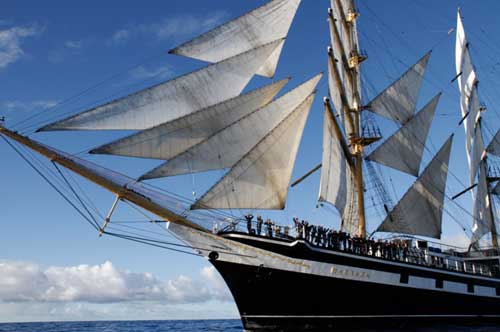 The Russian sail training vessel STS Pallada. (Pallada)
The Russian sail training vessel STS Pallada. (Pallada) A map of the tsunami debris field by Nikolai Maximenko and Jan Hafner of IPRC. The line shows the track of the Pallada where the debris was spotted between Sept. 21 and Sept. 28, 2011. The red rhombus (diamond) marks the location where the Japanese boat was found. The red circle denotes maximum debris density spotted by the Pallada. The purple shows the extent of the debris field from the updated university computer model as of Sept. 25. Click for larger image. (IPRC)
A map of the tsunami debris field by Nikolai Maximenko and Jan Hafner of IPRC. The line shows the track of the Pallada where the debris was spotted between Sept. 21 and Sept. 28, 2011. The red rhombus (diamond) marks the location where the Japanese boat was found. The red circle denotes maximum debris density spotted by the Pallada. The purple shows the extent of the debris field from the updated university computer model as of Sept. 25. Click for larger image. (IPRC)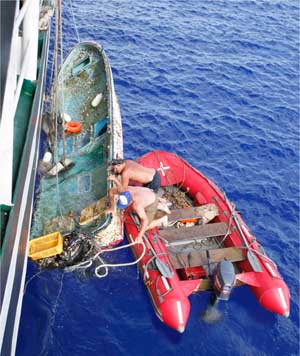 The crew of the Pallada hoists on board a Japanese boat, registered in Fukishima prefecture, and presumably washed out to sea during the March 11, 2011 tsunami. (Pallada)
The crew of the Pallada hoists on board a Japanese boat, registered in Fukishima prefecture, and presumably washed out to sea during the March 11, 2011 tsunami. (Pallada)

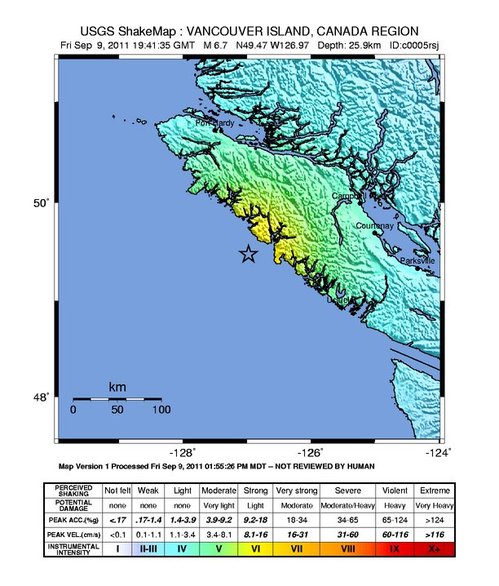
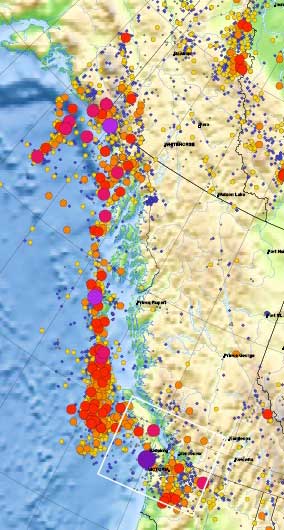 This detail of the Natural Resources Canada/ Earthquakes Canada shows the historical record of earthquakes along the northwest coast of British Columbia. The larger the circle, the greater the magnitude.
This detail of the Natural Resources Canada/ Earthquakes Canada shows the historical record of earthquakes along the northwest coast of British Columbia. The larger the circle, the greater the magnitude.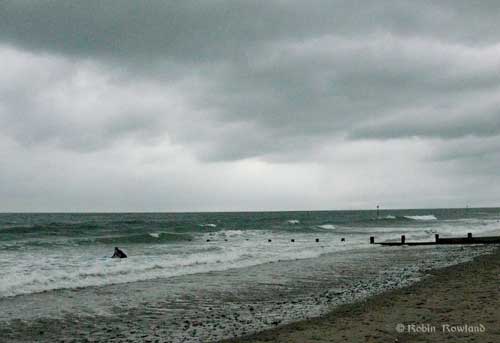 A surfer enters the water on a stormy beach at Tywyn, Wales, July, 2008. Scientists from nearby Aberystwyth University have studied kelp as a potential biofuel. The kelp was growing near a rocky outcrop some kilometres south of Tywyn at Aberystwyth Beach near Ceredigion. (Robin Rowland/Northwest Coast Energy News)
A surfer enters the water on a stormy beach at Tywyn, Wales, July, 2008. Scientists from nearby Aberystwyth University have studied kelp as a potential biofuel. The kelp was growing near a rocky outcrop some kilometres south of Tywyn at Aberystwyth Beach near Ceredigion. (Robin Rowland/Northwest Coast Energy News)